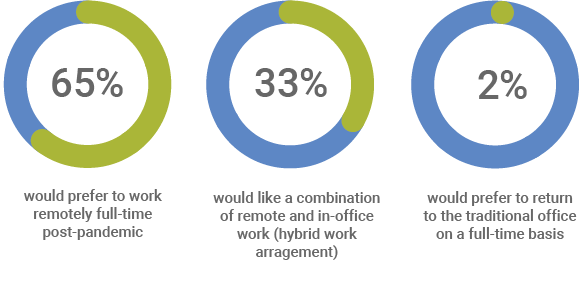
The COVID-19 pandemic has led to a significant shift in the way people work, with many companies adopting remote work policies to help slow the spread of the virus. However, remote work has been growing in popularity for years, and there are many benefits to working remotely that go beyond public health concerns. What are the key benefits of working remotely? Is remote work here to stay in 2023?
Benefits of working remotely
Increased Flexibility
Perhaps the biggest benefit of remote work is the flexibility it provides. Employees can work from anywhere with an internet connection, which means they can choose to work from home, a coffee shop, or even while traveling. This flexibility can be a game-changer for those who have long commutes, family obligations, or other responsibilities that make it difficult to work in a traditional office setting.
Improved Work-Life Balance
Remote work can also help to improve work-life balance. By eliminating the need to commute and allowing employees to work flexible hours, remote work can give employees more time to spend with family, pursue hobbies and interests, and take care of themselves. This can lead to lower stress levels, higher job satisfaction, and improved overall well-being.
Increased Productivity
Contrary to popular belief, remote work can actually lead to increased productivity. Studies have shown that remote workers are often more productive than their office-bound counterparts. This may be because remote workers have fewer distractions, can work during their most productive hours, and have more control over their work environment.
Cost Savings
Remote work can also be cost-effective for both employees and employers. For employees, working remotely can eliminate the need for expensive commutes and work clothes. For employers, remote work can reduce the need for office space, equipment, and utilities. This can lead to significant cost savings for businesses of all sizes.
Expanded Talent Pool
Remote work can also help businesses to expand their talent pool beyond their local area. By allowing employees to work remotely, businesses can hire the best talent regardless of where they live. This can be particularly valuable for companies that require specialized skills or expertise that may not be available in their local area.
Remote work offers many benefits for both employees and employers. From increased flexibility and improved work-life balance to increased productivity, cost savings, and an expanded talent pool, the advantages of remote work are clear. As more and more companies adopt remote work policies, it’s likely that we’ll continue to see the benefits of remote work grow in the years to come.
How productive remote work is?
Owllabs made a report of the state of remote work in 2022. They have made a survey of 2300 US workers that includes all of the work types – remote, hybrid, and in-office. These are the key findings and remote work statistics they have made:
- 62 percent of respondents feel more productive than they are working remotely.
- Number of remote employees increased by 24 % from 2021.
- 67% of hybrid workers said that they feel more productive than working from home.
- 77% of those who don’t feel productive working from home sais its because of distractions.
- Almost 50% of respondents said that they are worried that they will not be given the flexibility and work options they want.
If you don’t like numbers, here are some key findings from studies on the productivity of remote work:
- Increased Focus. One of the biggest benefits of remote work is that it can help employees to stay more focused on their work. Without the distractions of a busy office environment, employees can concentrate more deeply and get more done in less time.
- Fewer Interruptions. In addition to increased focus, remote work can also help to reduce interruptions that can derail productivity. For example, remote workers are less likely to be interrupted by coworkers dropping by their desks or by impromptu meetings.
- More Control over the Work Environment. A remote workforce also gives employees more control over their work environment. They can set up their workspace in a way that suits their needs and preferences, whether that means a quiet home office or a bustling coffee shop.
- Reduced Commute Time. Remote work can also lead to increased productivity by reducing the time and stress associated with commuting. This can give employees more time to work, exercise, or pursue other interests.
- Better Work-Life Balance. Finally, remote work can lead to improved productivity by helping employees achieve a better work-life balance. When employees have more control over their schedule and can work from anywhere, they are more likely to be satisfied with their job and less likely to burn out.
According to a survey conducted by FlexJobs in 2021, the majority of employees, specifically 65%, expressed their desire to continue working remotely, while 33% preferred a hybrid workplace model, and only 2% indicated their preference to return to the traditional office setting. Surprisingly, the survey found that 35% of the participants stated they would consider changing their job if required to work in an office again.

Of course, remote work is not without its challenges. It can be difficult to collaborate and communicate effectively when everyone is working from different locations, and some employees may struggle with isolation or the blurring of boundaries between work and home life. However, with the right tools, training, and support, these challenges can be overcome.
Remote vs in-office
Remote work allows employees to work from anywhere with an internet connection, which can provide more flexibility than in-person work. This can be especially beneficial for employees with family obligations, long commutes, or other responsibilities that make it difficult to work in a traditional office setting.
In-person work can be more effective for certain types of communication, such as brainstorming sessions or team building activities. Remote work, on the other hand, may require more intentional and structured communication to ensure effective collaboration and teamwork. In-person work can be noisy and distracting, while remote work can be isolating and lonely. Finding a balance between the two can be challenging, but it’s important to create a work environment that is conducive to productivity and focus, regardless of the setting.
Remote work can be more cost-effective for both employees and employers, as it eliminates the need for office space, equipment, and utilities. In-person work, on the other hand, may require more expenses related to commuting, work clothes, and other costs associated with working outside the home.
Remote work can help to improve work-life balance by eliminating the need for long commutes and allowing employees to work from home. However, it’s important to set clear boundaries between work and personal life to prevent burnout and maintain a healthy work-life balance.
In conclusion, remote work and in-person work both have their own unique advantages and disadvantages. The choice between the two will depend on a variety of factors, including individual preferences, job requirements, and company policies. Ultimately, the key is to find the work environment that allows you to be most productive, engaged, and satisfied in your work.
Is remote work here to stay?
The future of remote work is likely to continue to grow and become more common. The COVID-19 pandemic has accelerated the trend towards remote work, and many businesses and employees have found that it can be a viable and effective way of working.
One major advantage of remote work is the flexibility it provides. Employees can work from anywhere, which can help to reduce commute times and improve work-life balance. This can also help businesses to attract and retain talented employees who may not be able to work in a traditional office setting.
Another advantage of remote work is that it can be more cost-effective for businesses. They may not need to maintain as much office space or provide as many resources for remote workers.
However, there are also potential challenges with remote work, such as issues with communication, collaboration, and employee engagement. To overcome these challenges, businesses may need to invest in technology and tools that facilitate remote work, as well as training and support for remote workers.
Overall, it is likely that remote work will continue to grow in popularity and become more common in the future, but it will require careful planning and management to be successful.
Improve your remote work with isLucid
isLucid bridges verbal information with task management software, allowing team members to focus on the discussion and have organized written information. This helps to make a better decision-making process and keep teams aligned. Information from conversations are being organized in seconds and stored in any chosen task management platform, CRM or ATS. All the meetings become searchable, sharable, and actionable. By using integrated GPT3 notes and tasks are paraphrased and ready to go.
Communication between team members can become clear because of actionable items such as tasks, bookmarks, or meeting minutes. You can also save important meeting information with isLucid and share it with anyone you like – new employee or the one who did not attend the meeting. This helps to save time on keeping in touch with all decisions made during the meeting. With isLucid, organize and access all of your meetings at any time – they are stored for an unlimited amount of time. You can go back to a meeting that happened a long time ago and organize it the they you like or share it with your colleagues.
If you are interested in isLucid digital meeting assistant, get it for MS Teams.
You can also book a demo and get a walkthrough: Book a Demo.

